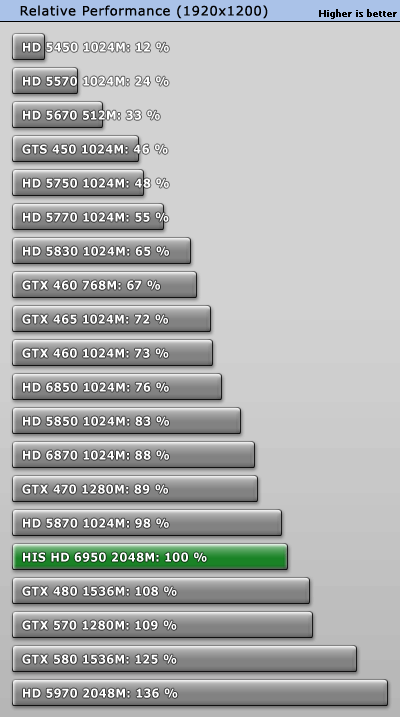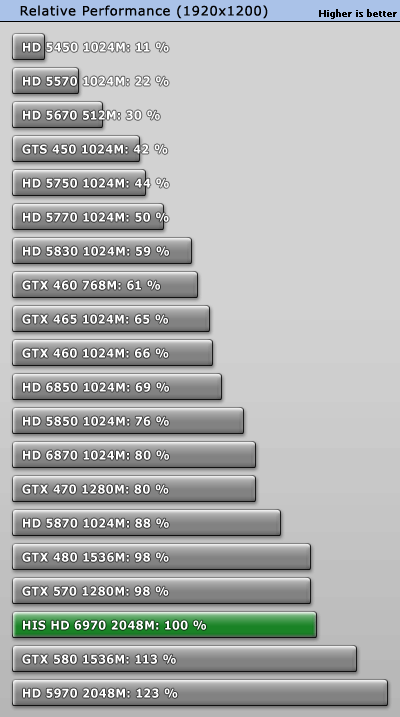Benetanegia
New Member
- Joined
- Sep 11, 2009
- Messages
- 2,680 (0.47/day)
- Location
- Reaching your left retina.
GTX 560 TI won't compete with 6970 or 6950 2GB
Only will compete with 6950 1GB, and won't beat it, at the best case they will trade blows.
GTX 560 Ti can't even touch 6970 because it will then cannibalize GTX 570.
Oh, it will surely perform on par with HD6950 2GB and once overclocked it will soundly beat stock GTX570 and HD6970. Performance difference between stock GTX580, 570 and 560 is not going to be much different than the one between HD6970, 6950 and 6870. Difference in both cases is around 10% in every step and that's how it's going to be this "generation" because there's a wall (40nm node) that prevents faster premium chips, but there's no such wall for performance/mainstream cards, so they have catched up. The high-end parts still have huge benefits for many enthusiast, like significantly better tesselation and GPGPU performance, also 64 bit support.
Compare these charts to look at the difference (~10%):


And here is a chart that I made that demostrates the performance that the GTX560 will have based on it's characteristics:
First the resume: performance icrease on Fermi cards is almost linear (+/- 2%) as their GFlops rise, as can be seen in the small chart below (performance numbers taken from W1zzard's HD6950 chart above):
GTS450 | 46 | 47.74
GTX465 | 72 | 67.86
GTX460 | 73 | 72.03
GTX470 | 89 | 86.36
GTX560 | ? | 100.00
GTX570 | 109 | 111.59
GTX480 | 108 | 106.86
GTX580 | 125 | 125.53
Here's the complete chart, just in case you want to check the math or if you want to check how, effectively, Fermi cards' performace is pretty much only based on relative GFlops (Gflops = 2*SP number*shader clock):
GTS450 | 783 | 192 | 601.34 | 47.74 | 16 | 12.53 | 47.74 | 3608 | 128 | 57.73 | 45.10 | 32 | 25.06 | 47.74
GTX465 | 607 | 352 | 854.66 | 67.86 | 32 | 19.42 | 74.02 | 3206 | 256 | 102.59 | 80.15 | 44 | 26.71 | 50.89
GTX460 1GB | 675 | 336 | 907.20 | 72.03 | 32 | 21.60 | 82.32 | 3600 | 256 | 115.20 | 90.00 | 56 | 37.80 | 72.03
GTX470 | 607 | 448 | 1,087.74 | 86.36 | 40 | 24.28 | 92.53 | 3348 | 320 | 133.92 | 104.63 | 56 | 33.99 | 64.77
GTX560 | 820 | 384 | 1,259.52 | 100.00 | 32 | 26.24 | 100.00 | 4000 | 256 | 128.00 | 100.00 | 64 | 52.48 | 100.00
GTX570 | 732 | 480 | 1,405.44 | 111.59 | 40 | 29.28 | 111.59 | 3800 | 320 | 152.00 | 118.75 | 60 | 43.92 | 83.69
GTX480 | 701 | 480 | 1,345.92 | 106.86 | 48 | 33.65 | 128.23 | 3696 | 384 | 177.41 | 138.60 | 60 | 42.06 | 80.14
GTX580 | 772 | 512 | 1,581.06 | 125.53 | 48 | 37.06 | 141.22 | 4008 | 384 | 192.38 | 150.30 | 64 | 49.41 | 94.15











